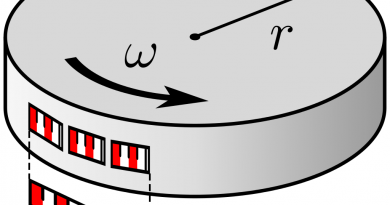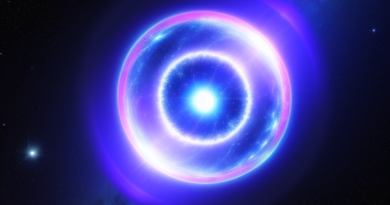Learning of information, not an interaction, induces the collapse
Luboš Motl, May 28, 2016
Some people often have the desire to «restore some realism». So they say that the collapse of the wave function isn’t tightly linked to some observer or his act of an observation. Instead, it’s a result of an interaction. Well, the interaction with a bigger object etc. may be a preparation for the measurement – and for the collapse – but it’s not the measurement and it doesn’t cause the collapse yet. After all, the collapse may take place without an interaction.
Zeilinger et al. have used a Michelson interferometer in their experiment but Inspiring Philosophy has shown a simpler prototypical example of the same idea. All deep new ideas about quantum mechanics may be extracted from the double slit experiment if you think about it deeply enough, Feynman once said, and this principle is applied here, too.
A double slit experiment creates an interference pattern when both slits are open. But it’s enough to place a detector/counter in slit A – and no detector in slit B – and the result is exactly the same as if you place detectors/counters in both slits, A and B.
You know, this really contradicts the idea that the collapse – and its experimental consequence, namely the destruction of the interference pattern – is caused by an interaction of the photon with the «which way detector». Why? Because if this were the case and if you studied the arrangement with one detector only in slit A, there would be a 50% probability that the interaction with the detector doesn’t occur (because the particle may have gone through slit B which has no detector). So the result should be something in between the interference pattern and the «two shadows» interference-free result.
However, quantum mechanics predicts and the experiment shows that you get the exact same result without any interference even if you only use one counter in slit A. The interference disappears because you (an observer who also observes the dots at the photographic plate at the end) have learned the which-way information, and that’s what forced you to use the collapsed wave function behind one of the slits. And the absence of the interaction with the detector (and the sound that accompanies it) is enough to learn.
In other words, if there’s only a detector in the slit A, 50% of the particles collapse into a packet near this detector, but the remaining 50% of the particles collapse into a wave packet behind slit B, a place which contains no detector and where no interaction of the particle with a detector has taken place.
Zeilinger et al. have also proposed a modification of the experiment in which an overwhelming majority of the objects collapses to places where no interaction has taken place. And because it was a few years after the «weak measurements» have introduced, they also discussed a weak-measurement interpretation of such modifications, something that is bound to lead to more confusion and misinterpretations.
Don’t get me wrong: some potential for an interaction of the observed physical system with a macroscopic object is a necessary condition for a measurement. But:
- in principle, an arbitrarily large physical system may be described by exact quantum mechanics so that no collapse takes place before the actual observer looks at it (there is no «unavoidable collapse») when macroscopic systems are included
- it is important to include the words «potential for an» in the line above because in many/most of the actual collapses, one may say that the collapse took place away or without any interaction of the observed particle(s) with a detector or another macroscopic system
Many people love to discuss the simple Everettian events in which a measured particle gets entangled with an apparatus, and both of them may get entangled with something else, perhaps with a cat or a human, or another human, and so forth. They discuss these trivial things and they believe that they solve something about what they consider to be a measurement «problem».
Needless to say, they don’t solve any problem at all. They are only «solving» as many «problems» as the number of new unnecessary «problems» they have added. They are just postponing the discussion. A measured particle may indeed get entangled with an apparatus, a cat, a human, or something else, but at the end, there still needs to be an observer who makes the observation. And the actual collapse to one of the a priori possible outcomes is always associated with the change of the knowledge of an observer because the collapse is nothing else than a generalization of Bayesian inference described by the probability amplitudes according to the quantum mechanical rules.
Just like the Bayesian probabilities don’t change without someone who subjectively learns about some information, the probability amplitudes in quantum mechanics don’t change without an observer who is learning some information from a quantum measurement!
Now, the people who simply hate the (no longer too) new foundations of physics may say that the interaction is taking place all the time, even if the detector is only in the slit A, because some object (the wave) objectively existed near both slits when there was the potential to detect the particle in detector A. However, if you embrace this attitude, it means that you are demonstrably pretending that some objects that are clearly unphysical are physical.
The reason is that you are saying that «something real exists near the slit A» (namely the «wave») whenever the particle has the potential to be seen either in slit A or B. However, you’re admitting that this «real thing» can’t have any impact on any experiments you are doing in the given situation. Pretty much by definition of the word «unphysical», a physicist must say that because this «something» isn’t observed even in principle, this «something» is unphysical – just like the particular value of the potential \(A_\mu\) in a gauge theory. And when something is unphysical (in this sense), it’s absolutely essential – really a matter of honesty – to admit that all the descriptions where this unphysical «something» has different values or properties are equally real or equally true in the scientific sense.
Because \(A_\mu\) isn’t directly measured, we say that all the configurations of \(A_\mu\) related by gauge transformations to each other are equally real and equally true. The realists in general and Bohmists in particular violate this rule – that descriptions with the same agreement with all the empirical evidence are equally real and equally true – which really proves that they are being dishonest.
Also note that the idea that «something is near the slit A» regardless of the reaction of the detector in the slit A implies a huge nonlocality of the most brutal kind. The collapse to a wave packet near the slit B was caused by some wave’s presence near the detector in the slit A. Once you consider similar nonlocal classical theories, you should consider the most generic values of all of their parameters – not only the values of the parameters that are more useful for counterfeiting of the correct theory (quantum mechanics). If you do so, you will unavoidably predict that this nonlocal classical theory predicts easily visible nonlocal phenomena with the probability approaching 100%, something that is clearly ruled out by the experiments.
So even in this sense, the people who keep on insisting on «realism plus nonlocality» are simply failing to behave as honest scientists. They are ideologically driven filth.


